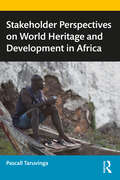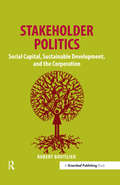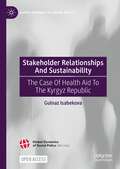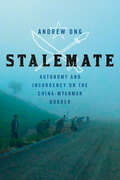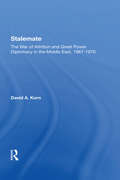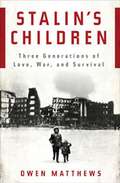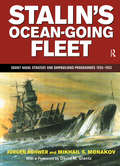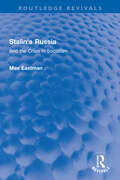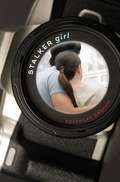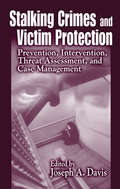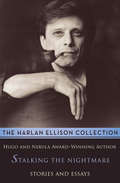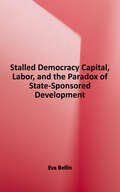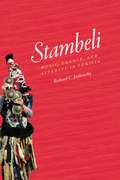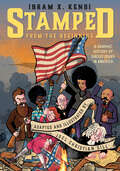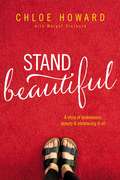- Table View
- List View
Stakeholder Perspectives on World Heritage and Development in Africa
by Pascall TaruvingaStakeholder Perspectives on World Heritage and Development in Africa argues that World Heritage Sites (WHS) across the African continent should adopt practical, innovative, creative, and alternative management approaches that bring greater socio-economic benefits to society, whilst protecting their Outstanding Universal Value. Drawing on empirical evidence gathered in conversation with stakeholders at WHS across Africa, the book explores the challenges involved in implementing conservation and socio-economic development as a stakeholder-driven process. Demonstrating that heritage can no longer be viewed as totally separate from its socio-economic context, Pascall argues that decisions about the management of heritage need to make sense at the local level if they are to be supported by stakeholders. As the book shows, heritage is still viewed and managed through systems, approaches, and strategies inherited from the colonial period, despite the increasing availability of inclusive governance systems. Stakeholders offer alternative, creative, and innovative approaches that capitalize on the potential of World Heritage to contribute to socio-economic development, whilst ensuring that its credibility and integrity are maintained. Stakeholder Perspectives on World Heritage and Development in Africa offers unique insights into local perspectives on World Heritage and development in Africa. The book will be essential reading for academics, students, development partners, and practitioners around the world who are interested in museums and heritage, conservation, development, and the African continent. Also, the book will be useful in the preparation of nomination dossiers, management plans, development plans, and in disaster risk management at WHS.
Stakeholder Politics: Social Capital, Sustainable Development, and the Corporation
by Robert BoutilierThe war is over. The largest corporations in the world are now committed to sustainability. But, behind the public relations gloss, corporate executives and managers are perplexed. The majority of them have a genuine desire to work in an ethical and sustainable manner. Yet, when they engage with their stakeholders for that purpose, they unexpectedly encounter a world of hardball politics full of hostile activists, self-interested elites and unpredictable attacks. Unfortunately, corporate management is too often unskilled in this rough-and-tumble world. While managers rely on facts and rational analysis, their self-appointed critics have mastered the arts of political discourse, issue framing and media manipulation. At the same time, as corporations extend their global reach, their third-world stakeholder communities are beset with a variety of poverty-maintaining and sustainability-thwarting conditions. In many parts of the world, communities suffer from entrenched divisions, exclusion from power, unpredictable violence and economic dependency. In order to both reduce reputational risk and to contribute to sustainable development, companies need the equivalent of roadmaps of the socio-political terrain in their stakeholder networks.This book moves on to next challenge of giving companies what they need now: namely, "how to" guides addressing the twin problems of firstly maintaining political legitimacy (talking the talk), and, secondly, promoting sustainable development (walking the walk). They need to learn how to both play stakeholder politics and collaborate with stakeholders towards sustainability goals. Most companies have already encountered or anticipated the barriers that this book addresses, and managers will recognize the dilemmas described.Stakeholder Politics is the first book to offer a method for classifying and dealing with these socio-political problems.The book presents a typology of stakeholder networks that will help managers and community leaders identify and improve the social capital patterns in their own networks. Once they know what patterns they have, they can move their networks towards those that foster sustainable community development. The author describes vivid cases in which managers and community stakeholders have already used the approach successfully. At the same time, managers get handy tools for predicting and avoiding community-level socio-political risk around stakeholder issues: most notably, the Stakeholder 360 which has been successfully used in Canada and Australia with large groups of managers learning about stakeholder engagement.The book has been written for an audience of both managers and academics. Those working in developing countries with difficult stakeholder issues will find it indispensable.
Stakeholder Relationships And Sustainability: The Case Of Health Aid To The Kyrgyz Republic (Global Dynamics of Social Policy)
by Gulnaz IsabekovaThis open-access book analyses how stakeholder relationships impact the sustainability of health aid. It does this by providing an overarching analytical framework, which allows for a systematic analysis of sustainability, relationships, and a possible causal link between these phenomena. The book goes beyond universal paradigms and detailed single-case studies by offering a thorough analysis of development projects to identify the factors that are also applicable to similar initiatives in comparable contexts.Empirically, it focuses on two health initiatives, both implemented in the Kyrgyz Republic, a country pursuing a sector-wide approach to health aid. Unique primary material provides insights into a geographic region that is mostly neglected, and will be of interest to students and researchers of social policy, development studies, international health and those focusing on the post-Soviet region and Central Asia.
Stakes Is High: Life After the American Dream
by Mychal Denzel SmithBrave, clear-eyed, and passionate, Stakes Is High is the book we need to guide us past crisis mode and through an uncertain future.The events of the past decade have forced us to reckon with who we are and who we want to be. We have been invested in a set of beliefs about our American identity: our exceptionalism, the inevitable rightness of our path, the promise that hard work and determination will carry us to freedom. But in Stakes Is High, Mychal Denzel Smith confronts the shortcomings of these stories -- and with the American Dream itself -- and calls on us to live up to the principles we profess but fail to realize.In a series of incisive essays, Smith exposes the stark contradictions at the heart of American life, holding all of us, individually and as a nation, to account. We've gotten used to looking away, but the fissures and casual violence of institutional oppression are ever-present.There is a future that is not as grim as our past. In this profound work, Smith helps us envision it with care, honesty, and imagination.
Stalemate: Autonomy and Insurgency on the China-Myanmar Border
by Andrew OngStalemate reveals the history and contemporary politics of the United Wa State Army (UWSA), Asia's strongest insurgent army on Myanmar's border with China. This ethnographic tale recounts how a highland group, often dismissed as rebels or narcotraffickers, maintains a relational autonomy between two powerful lowland states. The Wa polity engages rather than evades these surrounding states, yet struggles to fit into their registers of sovereignty and statehood. Andrew Ong examines political culture among Wa elites and people, UWSA external relations, and capital flows with neighboring China, showing how Wa autonomy is enacted through careful navigation of complex borderland geopolitics and the shadow economy. He analyzes the seeming stalemate between the Myanmar state and the UWSA as one of tactical dissonance—adopting simultaneous postures of authority and subordination and creating disruptions and connections. Stalemate illuminates how seemingly ambiguous and disorderly practices of political signaling, economic regulation, and military governance produce relative stability, challenging our assumptions about state-like processes at the peripheries.
Stalemate: The War Of Attrition And Great Power Diplomacy In The Middle East, 1967-1970
by David A. KornFor three years following Israel’s victory in the Six-Day War, Egypt, with a massive infusion of weaponry from the Soviet Union, continued to do battle with Israel in what became known as the War of Attrition. The history of these years holds the key to understanding the Arab-Israeli conflict today. In this book, David A. Korn offers a detailed insider’s account of the first—and, until recently, the only—U.S.-Soviet cooperative effort to bring peace to the Middle East and an explanation of the origin of the “land for peace” formula. He relates a fascinating story of political intrigue in Washington and Jerusalem that stymied the efforts of peacemakers; of Egypt’s massing a huge army along the west bank of the Suez Canal; and of Israel’s desperate search for a strategy to hold the east bank with a token force and minimal losses. He also describes the incredible miscalculation that nearly plunged Israel into war with the Soviet Union and the great heroism on both sides of the Suez line. This book fills a large gap in the history of the conflict between Israel and its Arab neighbors and is the first to analyze war and diplomacy in the Middle East during the critical years of 1967–1970 from the Egyptian as well as the Israeli point of view. To both, Korn brings penetrating insights based on a wealth of materials never before published. It is a gripping story by a writer who had a grandstand seat on the line.
Stalin's Children: Three Generations of Love, War, and Survival
by Owen MatthewsA transcendent history/memoir of one family's always passionate, sometimes tragic connection to Russia. On a midsummer day in 1937, a black car pulled up to a house in Chernigov, in the heart of the Ukraine. Boris Bibikov--Owen Matthews's grandfather--kissed his wife and two young daughters good-bye and disappeared inside the car. His family never saw him again. His wife would soon vanish as well, leaving Lyudmila and Lenina alone to drift across the vast Russian landscape during World War II. Separated as the Germans advanced in 1941, they were miraculously reunited against all odds at the war's end. Some twenty-five years later, in the early 1960s, Mervyn Matthews--Owen's father--followed a lifelong passion for Russia and moved to Moscow to work for the British embassy. He fell in and out with the KGB, and despite having fallen in love with Lyudmila, he was summarily deported. For the next six years, Mervyn worked day and night to get Lyudmila out of Russia, and when he finally succeeded, they married. Decades on from these events, Owen Matthews--then a young journalist himself in Russia--came upon his grandfather's KGB file recording his "progress from life to death at the hands of Stalin's secret police." Stimulated by its revelations, he has pieced together the tangled and dramatic threads of his family's past and present, making sense of the magnetic pull that has drawn him back to his mother's homeland. Stalin's Children is an indelible portrait of Russia over seven decades and an unforgettable memoir about how we struggle to define ourselves in opposition to our ancestry only to find ourselves aligning with it. "I came to Russia to get away from my parents," writes Matthews. "Instead I found them there, though for a long time I didn't know it or refused to see it. This is a story about Russia and my family, about a place which made us and freed us and inspired us and very nearly broke us. And it's ultimately a story about escape, about how we all escaped from Russia, even though all of us--even my father, a Welshman, who has no Russian blood, even me, who grew up in England--still carry something of Russia inside ourselves, infecting our blood like a fever."
Stalin's Ocean-going Fleet: Soviet Naval Strategy And Shipbuilding Programs, 1935-53 (Cass Series: Naval Policy And History Ser. #Vol. 11)
by Jurgen RohwerIn this work, two senior naval historians analyze the discussions held in leading Soviet political, military, and naval circles concerning naval strategy and the decisions taken for warship-building programmes. They describe the reconstitution of the fleet under difficult conditions from the end of the Civil War up to the mid-1920s, leading to a change from classical naval strategy to a Jeune ecole model in the first two Five-Year Plans, including efforts to obtain foreign assistance in the design of warships and submarines. Their aim is to explain the reasons for the sudden change in 1935 to begin building a big ocean-going fleet. After a period of co-operation with Germany from 1939-41, the plans came to a halt when Hitler attacked the Soviet Union in 1941. Finally, this work covers the reopening of the naval planning processes in 1944 and 1945 and the discussions of the naval leadership with Stalin, the party and government officials about the direction of the new building programmes as the Cold War began.
Stalin's Russia: And the Crisis in Socialism (Routledge Revivals)
by Max EastmanFirst published in 1940, Stalin’s Russia is a close study of the development of the Stalinist regime and the flaws in socialist doctrine that made it possible. The book examines the contrasts between the "free and equal" society heralded by the Marxist-Leninist programme and the totalitarian state that emerged in its place. It makes use of a wealth of material to cast light on the inner workings of Stalin’s regime. It explores the significance of the Stalin-Hitler pact, and argues that the word "socialism" itself became a liability to any genuine movement of liberation as a result.
Stalinism and Soviet Cinema (Soviet Cinema Ser.)
by Richard Taylor Derek SpringStalinism and Soviet Cinema marks the first attempt to confront systematically the role and influence of Stalin and Stalinism in the history and development of Soviet cinema. The collection provides comprehensive coverage of the antecedents, role and consequences of Stalinism and Soviet cinema, how Stalinism emerged, what the relationship was between the political leadership, the cinema administrators, the film-makers and their films and audiences, and how Soviet cinema is coming to terms with the disintegration of established structures and mythologies. Contributors from Britain, America and the Soviet Union address themselves to the importance of the Stalinist legacy, not only to the history of Soviet cinema but to Soviet history as a whole.
Stalinism and the Soviet-Finnish War, 1939–40: Crisis Management, Censorship and Control (St Antony's Series)
by Malcolm L. SpencerThis book offers an illuminating bridge between the political and social dimensions of the Soviet-Finnish War of 1939-40. The conflict represented a significant crisis for the Soviet Union, inspiring international condemnation and a significant loss of face for its supporters, both at home and abroad. The focus of this study is not upon the military dynamics of the war, but upon its ability to influence events, interpretations and interactions between agents and institutions within the Soviet Union and the wider international communist movement. Through original archival research, this book considers the ways in which the Soviet leadership reacted to the crisis, the tools at its disposal, and the effectiveness with which it managed to manipulate and control the spread of information through official and unofficial channels. It contributes to a more complete and complex picture of the inter-related nature of Soviet politics, propaganda and mass media in this period.
Stalinist City Planning
by Heather DehaanBased on research in previously closed Soviet archives, this book sheds light on the formative years of Soviet city planning and on state efforts to consolidate power through cityscape design. Stepping away from Moscow's central corridors of power, Heather D. DeHaan focuses her study on 1930s Nizhnii Novgorod, where planners struggled to accommodate the expectations of a Stalinizing state without sacrificing professional authority and power.Bridging institutional and cultural history, the book brings together a variety of elements of socialism as enacted by planners on a competitive urban stage, such as scientific debate, the crafting of symbolic landscapes, and state campaigns for the development of cultured cities and people. By examining how planners and other urban inhabitants experienced, lived, and struggled with socialism and Stalinism, DeHaan offers readers a much broader, more complex picture of planning and planners than has been revealed to date.
Stalker Girl
by Rosemary GrahamDuring a difficult time in her life, when her mother and stepfather have broken up and her father cancels a trip she has been anticipating, Carly becomes obsessed with her ex-boyfriend's new girlfriend.
Stalking Crimes and Victim Protection: Prevention, Intervention, Threat Assessment, and Case Management
by Joseph A. DavisAlthough stalking is an age-old phenomenon, it is only recently receiving due attention. In a span of just ten years, all fifty states have passed anti-stalking legislation. For the first time, Stalking Crimes and Victim Protection: Prevention, Intervention, Threat Assessment, and Case Management brings together in one source all the research done
Stalking the Atomic City: Life Among the Decadent and the Depraved of Chornobyl
by Markiyan Kamysh&“His voice must be heard.&”—Patti Smith&“A poetic rush to madness. . . a stunning, original voice as lyrical as it is unnerving."—Alan Weisman, author of The World Without Us and Countdown"In the shadow of catastrophe, Markiyan Kamysh writes with all of youth&’s wayward lyricism, like a nuclear Kerouac."—Rob Doyle, author of ThresholdA rare portrait of the dystopian reality of Chornobyl, Ukraine, as it was before the Russian occupation of 2022.Since the nuclear disaster in April 1986, Chornobyl remains a toxic, forbidden wasteland. As with all dangerous places, it attracts a wild assortment of adventurers who feel called to climb over the barbed wire illegally and witness the aftermath for themselves. Breaking the law here is a pilgrimage: a defiant, sacred experience mingled with punk rock, thrash metal, death, decay, washed down with a swig of high-proof Vodka.Author Markiyan Kamysh grew up with intimate knowledge of the devastation of the nuclear plant's explosion—his father was an on-site liquidator after the disaster and died of exposure when Markiyan was young. This, too, drives him in searching for meaning instead in the beauty and chaos of what remains.In Stalking the Atomic City, Kamysh tells us about thieves who hide in the abandoned buildings, the policemen who chase them, and the romantic utopists who have built families here, even as deadly toxic waste lingers in the buildings, playgrounds, and streams. The book is complete with stunning photographs that may well be the last images to capture Chornobyl&’s desolate beauty since occupying Russian forces started to loot and destroy the site in March 2022.An extraordinary guide to this alien world many of us will never see, Kamysh&’s singular prose that is both brash and bold, compared to Kerouac and gonzo journalists, captures the understated elegance and timeless significance of this dystopian reality.
Stalking the Nightmare: Stories and Essays
by Harlan EllisonPure, hundred-proof distillation of Ellison. A righteous verbal high. Here you will find twenty of his very best stories and essays, including the four-part 'Scenes from the Real World," an anecdotal history of the doomed TV series, The Starlost, that he created for NBC; "Tales from the Mountains of Madness"; and his hilariously brutal reportage on the three most important things in life, sex, violence, and labor relations. With an absolutely killer foreword by Stephen King.
Stalled Democracy: Capital, Labor, and the Paradox of State-Sponsored Development
by Eva BellinIn this ambitious book, the author examines the dynamics of democratization in late-developing countries where the process has stalled. The author focuses on the pivotal role of social forces and particularly the reluctance of capital and labor to champion democratic transition, contrary to the expectations of political economists versed in earlier transitions. She argues that the special conditions of late development, most notably the political paradoxes created by state sponsorship, fatally limit class commitment to democracy. In many developing countries, she contends, those who are empowered by capitalist industrialization become the allies of authoritarianism rather than the agents of democratic reform. The author generates her propositions from a close study of a singular case of stalled democracy: Tunisia. Capital and labor's complicity in authoritarian relapse in that country poses a puzzle. The author's explanation of that case is made more general through comparison with the cases of other countries, including Mexico, Indonesia, South Korea, Turkey, and Egypt. Stalled Democracy also explores the transformative capacity of state-sponsored industrialization. By drawing on a range of real-world examples, she illustrates the ability of developing countries to reconfigure state-society relations, redistribute power more evenly in society, and erode the peremptory power of the authoritarian state, even where democracy is stalled.
Stambeli: Music, Trance, and Alterity in Tunisia (Chicago Studies in Ethnomusicology)
by Richard C. JankowskyIn Stambeli, Richard C. Jankowsky presents a vivid ethnographic account of the healing trance music created by the descendants of sub-Saharan slaves brought to Tunisia during the eighteenth and nineteenth centuries. Stambeli music calls upon an elaborate pantheon of sub-Saharan spirits and North African Muslim saints to heal humans through ritualized trance. Based on nearly two years of participation in the musical, ritual, and social worlds of stambeli musicians, Jankowsky’s study explores the way the music evokes the cross-cultural, migratory past of its originators and their encounters with the Arab-Islamic world in which they found themselves. Stambeli, Jankowsky avers, is thoroughly marked by a sense of otherness—the healing spirits, the founding musicians, and the instruments mostly come from outside Tunisia—which creates a unique space for profoundly meaningful interactions between sub-Saharan and North African people, beliefs, histories, and aesthetics. Part ethnography, part history of the complex relationship between Tunisia’s Arab and sub-Saharan populations, Stambeli will be welcomed by scholars and students of ethnomusicology, anthropology, African studies, and religion.
Stambeli: Music, Trance, and Alterity in Tunisia (Chicago Studies in Ethnomusicology)
by Richard C. JankowskyIn Stambeli, Richard C. Jankowsky presents a vivid ethnographic account of the healing trance music created by the descendants of sub-Saharan slaves brought to Tunisia during the eighteenth and nineteenth centuries. Stambeli music calls upon an elaborate pantheon of sub-Saharan spirits and North African Muslim saints to heal humans through ritualized trance. Based on nearly two years of participation in the musical, ritual, and social worlds of stambeli musicians, Jankowsky’s study explores the way the music evokes the cross-cultural, migratory past of its originators and their encounters with the Arab-Islamic world in which they found themselves. Stambeli, Jankowsky avers, is thoroughly marked by a sense of otherness—the healing spirits, the founding musicians, and the instruments mostly come from outside Tunisia—which creates a unique space for profoundly meaningful interactions between sub-Saharan and North African people, beliefs, histories, and aesthetics. Part ethnography, part history of the complex relationship between Tunisia’s Arab and sub-Saharan populations, Stambeli will be welcomed by scholars and students of ethnomusicology, anthropology, African studies, and religion.
Stambeli: Music, Trance, and Alterity in Tunisia (Chicago Studies in Ethnomusicology)
by Richard C. JankowskyIn Stambeli, Richard C. Jankowsky presents a vivid ethnographic account of the healing trance music created by the descendants of sub-Saharan slaves brought to Tunisia during the eighteenth and nineteenth centuries. Stambeli music calls upon an elaborate pantheon of sub-Saharan spirits and North African Muslim saints to heal humans through ritualized trance. Based on nearly two years of participation in the musical, ritual, and social worlds of stambeli musicians, Jankowsky’s study explores the way the music evokes the cross-cultural, migratory past of its originators and their encounters with the Arab-Islamic world in which they found themselves. Stambeli, Jankowsky avers, is thoroughly marked by a sense of otherness—the healing spirits, the founding musicians, and the instruments mostly come from outside Tunisia—which creates a unique space for profoundly meaningful interactions between sub-Saharan and North African people, beliefs, histories, and aesthetics. Part ethnography, part history of the complex relationship between Tunisia’s Arab and sub-Saharan populations, Stambeli will be welcomed by scholars and students of ethnomusicology, anthropology, African studies, and religion.
Stamped from the Beginning: A Graphic History of Racist Ideas in America
by Ibram X. Kendi Joel Christian GillA striking graphic novel edition of the National Book Award-winning history of how racist ideas have shaped American life—from the #1 New York Times bestselling author of How to Be an Antiracist.Racism has persisted throughout history—but so have antiracist efforts to dismantle it. Through deep research and a gripping narrative that illuminates the lives of five key American figures, preeminent historian Ibram X. Kendi reveals how understanding and improving the world cannot happen without identifying and facing the racist forces that shape it.In collaboration with award-winning historian and comic artist Joel Christian Gill, this stunningly illustrated graphic-novel adaptation of Dr. Kendi&’s groundbreaking Stamped from the Beginning explores, with vivid clarity and dimensionality, the living history of America, and how we can learn from the past to work toward a more equitable, antiracist future.
Stamps, Nationalism and Political Transition
by Stanley D. BrunnThis book explores how states in political transition use stamps to promote a new visual nationalism. Stamps as products of the state and provide small pieces of information about a state’s heritage, culture, economies and place in the world. These depictions change over time, reflecting political and cultural changes and developments. The volume explores the transition times in more than a dozen countries from Africa, Latin America, Asia and Europe. Specifically addressed are the stamp topics, issues and themes in the years before and after such major changes occurred, for example, from a European colony to political independence or from a dictatorship to democracy. The authors compare the personalities, histories, and cultural representations "before" the transition period and how the state used the "after" event to define or redefine its place on the world political map. The final three chapters consider international themes on many stamp issues, one being stamps with Disney cartoon characters, another on "themeless" Forever stamps, and the third on states celebrating women and their accomplishments. This volume has wide interdisciplinary relevance and should prove of particular interest to those studying geopolitics, political transition, visual nationalism, soft power and visual representations of decolonializing.
Stan Hochman Unfiltered: 50 Years of Wit and Wisdom from the Groundbreaking Sportswriter
by Gloria HochmanThe late Philadelphia Daily News sportswriter Stan Hochman was known for his many zingers, such as “Harry Litwack, the stoic Temple coach, stalks the sidelines like a blind man at a nudist colony.” As a reporter, he was more interested in how athletes felt, what their values were, how they lived their lives, or what made them tick than he was about how many runs they scored or punches they landed. In Stan Hochman Unfiltered, his wife Gloria collects nearly 100 of his best columns from the Daily News about baseball, horse racing, boxing, football, hockey, and basketball (both college and pro), as well as food, films, and even Liz Taylor. Each section is introduced by a friend or colleague, including Garry Maddox, Bernie Parent, Larry Merchant, and Ray Didinger, among others. Hochman penned a candid, cantankerous column about whether Pete Rose belongs in the Baseball Hall of Fame; wrote a graphic account of the Muhammad Ali and Joe Frazier fight of the century; and skewered Norman “Bottom Line” Braman, the one-time owner of the Eagles. He also wrote human-interest stories, including features about the importance of kids with special needs playing sports. In addition to being a beloved writer, Hochman was also known for his stint on WIP’s radio as the Grand Imperial Poobah, where he would settle callers’ most pressing debates. Hochman long earned the respect and admiration of his subjects, peers, and readers throughout his career, and Stan Hochman Unfiltered is a testament to his enduring legacy.
Stand Beautiful: A story of brokenness, beauty and embracing it all
by Chloe Howard Margot StarbuckIn Stand Beautiful, international speaker and TEDx presenter Chloe Howard shares her story of overcoming injustice, battling self-doubt, and rising up to speak out, fueled by a powerful encounter with Bono from the band U2. Chloe’s story shows that even through brokenness and shame, we can venture toward hope, accept our unique selves, and share in our human experiences. Chloe boldly addresses the unlikely hero in each of us. Readers will be inspired to be brave, to speak up against injustice, and redefine beauty as more than what the eye can see. Chloe shares how faith enabled her to endure physical and emotional pain, spurring readers to delve into authenticity and stand beautiful.
Stand Up for Singapore?: National Belonging among Gay Men in the Lion City
by Chris K. TanThis book details queer Singaporeans’ efforts to fashion their sense of national belonging and highlights how the Singaporean state could have better incorporated its diverse population into its nation-building framework. Inspired by previous studies that document the history of the gay rights movement, the construction of post-colonial lesbian identities, and online queer activism, this book invokes the concept of "cultural citizenship." It argues that as citizens, gay men appreciate the material wealth the People’s Action Party (PAP) has created. Yet, the PAP’s illiberal governance inhibits the development of genuine fondness for the party and, by extension, the nation. Worse, the state’s heteronormative social policies further alienate these men. Even so, queer Singaporeans continue to assert their national belonging during Pink Dot and other queer events. As the first monograph to focus on Singaporean gay men, this book aims to enrich scholarly understanding of queer life in Southeast Asia. Academics and students of anthropology and sociology (especially those interested in the nation-state), Southeast Asian Studies, and Queer Studies will find this book innovative and insightful.
